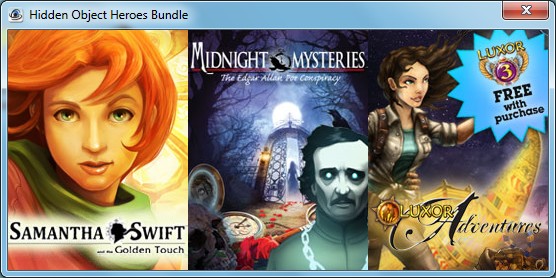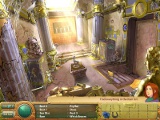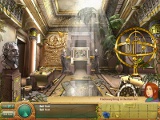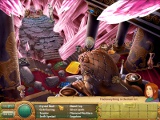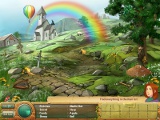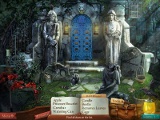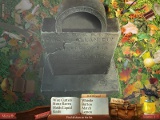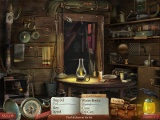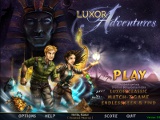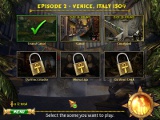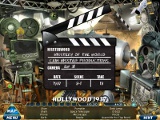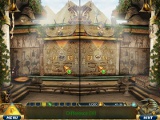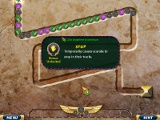





Amazing Adventures: Special Edition Bundle:
Amazing Adventures: The Lost Tomb
Amazing Adventures: Around the World
This is an older set of object-finding games bundled together, meaning that it was made for a lower screen resolution than mine, and looks a bit fuzzy, and as long as Windows is hogging resources by polling for network connections, its DirectX version may make the computer lock up. Unlike most bundles of older games, though, this is not two games with a launcher app, but a genuine two-in-one game, so that I only have to change the process priority when starting it, and can then switch between games. If I'm quick, I can reprioritize both "AmazingAdventuresBundle.exe" processes in the Task Manager before the monitor goes black and the game screen opens.
The first game is centered on Egypt, although the saloon and the
horse-in-stable screens make me think the gamemakers hadn't decided on a locale
yet when they started developing. The "story" is a journal that covers 20
missions: for each finished mission, the journal opens on a new page, revealing
a tidbit of information on ancient Egyption culture and a piece of the puzzle
that will finally lead to the secret tomb that the player has set out to
discover. During the mission, the player has to find 10 hidden objects in a
scene, solve a jigsaw/swap-tiles/match-tiles/spot-the-differences game , find 10
more hidden objects in the next scene hinted at by the interim game, etc. Each
screen or game is considered a level; several levels make up a mission.
The hidden objects screens are amazing. As always with hidden object games,
especially the older ones where the objects are shamelessly out of proportion
(like a tiny chest dwarfed by a huge matchstick), the objects are shrunk, made
half-transparent, recoloured and/or made to seem painted or carved just to
escape my notice; and to make it harder, some descriptions are in riddle form or
generalized for multiple objects, so that "2 knives" can equal "knife" and
"putty knife". Each screen is crammed full of objects, so that the number of
objects seems overkill compared to the 10 or so to find, plus the 21 scarabs
that must be found to unlock the "secret game", but each location is frequently
revisited, so there are many opportunities for finding the scarab it hides.
Hints are given by the hint button, which takes a while to "reload" after
each use, but doesn't cost the player anything. However, there is a whopping
15000 point bonus for not using it. This is a points-collecting game: each
object found is good for 2000 points, quickly finding one object after another
means extra points, and not using hints adds a bonus when the level is finished.
When I get enough points, a message appears, sometimes while I'm in the middle
of an object search, that I've been promoted to a next rank. Annoyingly, though,
when I go to a new location and pore over the screen trying to locate three
objects to click in succession, the game decides I'm taking too long and goes
into Pause mode to show a reminder about the hint button. It does this, not once
for every new game, but in every location. Less annoyingly, it also shows
a message when there are only 3 minutes left. The time for each location with 10
objects to find (or more if the direction is "n objects") is about 15 minutes;
time doesn't get shorter as the player finishes more missions, nor does the list
of things to find get longer, which is just as well, as this game has so many
searches that it can't comfortably be finished in one sitting. After the nth
visit to the wall painting, submerged temple, airport etc. I was ready to
scream.
The interim games can be: jigsaw puzzles of part of a location; swap-tile
puzzles of part of a location (often, the same graphic can be used for both); a
split-screen where you have to click the differences between the two halves; or
a match-tiles game where you have to match two identical images, two similar
images, two images of the same colour or two complementary images (like cocktail
and shaker), just to keep the player awake. These games garner points, and again
there are extra points for speed. The elements of all these games are used in
the final game, where (spoiler, as the hint button won't work here) I have to
drag stuff, rotate stuff by right-clicking and swap tiles. Failure to understand
this means running out of time, and having to start over while feeling a right
twit. Unlike the object screens, some interim games do get harder with time: the
spot-the-difference games add more and more differences.
After finding 21 scarabs, I can play the "secret game", which means emptying
every location of all of its hidden objects as their description appears in the
object list. There are over 80 for each location. As before, the descriptions
can be riddles or refer to two or more (maximum encountered: six) items, and
there are extra points for speed. This game's object screens really are blank
slates: finding all the objects clears them out completely, as opposed to the
screens in Luxor Adventures, where some "objects" are
part of the background to confuse the player.
The second game is much like the first, with the same hint
button and point bonuses, even playing the same suspenseful background music
with scraping rock sounds, but with even more amazing hidden object screens. As
the title implies, this game, while looking for pieces of pottery that will lead
to the most expensive diamond in the world, jumps all over the globe, which
means more possibilities for locations: a British street scene, a jeep in the
savannah, a castle room, the pages of an open book, or a motorboat facing a
waterfall. I now have to find 50 gems instead of 21 scarabs (2 per location, as
there are 25 locations) to unlock two secret games: the one that clears out all
hidden object screens, and the one that lets me play all spot-the-differences
games. As in the first game, I can open the journal at its latest page, but
can't leaf back to see which places I've visited and, therefore, what screens
still hold unfound gems; but the top left screen corner tells me how many gems
have been found in a given location. The interim games have been extended with a
new spot-the-differences game that shows a split screen plus a row of objects to
put back into the screen half where they are missing, a puzzle where all tiles
are in the right place but have to be rotated, and a game of finding words in a
screen of letters. The jigsaw puzzles now have regular jigsaw pieces, or ones
that look like shards of stone. Most interim games still anticipate the next
scene, but the "spot the differences" games use the scene just played. An odd
new interim game, shown in the last screenshot below, looks like a match-3
playfield, but only one tile has to be clicked away at the time to destroy the
squares and fully reveal the scene under them.
I played like mad to find all the gems and check out the hidden games. The
number of objects per location is now between 70 and 80, less than in the first
game, but still a lot (and there are more locations, see first screenshot below,
so the grand total is probably the same) while the differences games have 10
differences per location.
1001 Nights: The Adventures of Sindbad
When I redeemed this game, the new CasualGames.com site had been up for a few
months, and the redeeming screen slipped in a new, pre-ticked option: game
backup CD, which would add money to my free order for the handling and shipping
of 1 CD, presumably a CD-R. I quickly unticked that option, and will from now on
be on my guard; much as I like hardcopy, I'm not too stupid to locate the
downloaded game and burn it to CD myself, and if that CD goes rotten, as CD-R
media tend to do, I can re-download it - right? Or is the site getting over-full
and overstrained and do its owners want to limit downloading, as well as chuck a
few oldies? But, back to the game.
This is the first game that I've seen to use drawings - fine pen and ink
drawings - instead of rendered 3D. So it uses a technique that I've seen in
other drawn games, presumably because drawings are more suitable for it: have
the player search, not for whole items, but for fragments until the whole item
is assembled. And then, generally, use the item as a tool. In this game, the
item has to be stuck in a designated spot, usually a similarly shaped hollow or
thin outline. Whole items are also looked for, through a list of objects, or a
set of riddles, or a series of silhouettes. Another variation is to take a row
of squares out of the scenery, and have the player click on the spot in the
scene where they were taken from: great when there's nothing actually hidden,
and crystal fragments or runes spring up on every located square. This is also
the first game I've seen where the eye-candy main character is male (although,
let's not forget the princess) and, like all incarnations of Sindbad the Sailor,
more a Hollywood hero than a convincingly real person. In this tale, which
starts fairly normally (for a tale from 1001 Nights) but becomes weirder and
weirder, his hero status is inflated beyond belief: at one point, he has "saved
the world the gods created". Mmyeah. In keeping with this, the background music
is the kind of pseudo-oriental music that would do well in a Hollywood film.
The story starts in Basra, Iraq, where the economy has worsened because an
evil mage is on the throne. Sindbad, a humble fisherman, falls overboard one day
and notices a sunken ship surrounded with treasures. He collects them to sell
them and buy Basra's hungry inhabitants some food, even though an amulet warns
him not to. Sure enough, word gets around, he is arrested, ordered to show where
the treasures came from and thrown overboard on that spot. Underwater, the
amulet talks to him again, telling him to assemble three objects. That done, the
ship somehow draws him in, and he stands face to face with a wooden figure who
is now part of the ship, but who was once princess Chalida, cursed to spend her
life as a ship for refusing to hand her crown with seven magical gems to a
octopus-like sea demon: the aforementioned evil mage. Only if she gathers all
seven gems will the curse be broken. Sindbad (well, the player) has to
reconstitute a map that will lead them to seven islands, each island rising out
of it when selected as a destination, and then free each gem from its guardian.
This means eight times (one extra time for the showdown at the octopus palace)
hidden objects searches within two or three screens, followed by a puzzle (slide
puzzle, pipe game or other) to finally get the gem; particularly mind-bending is
the one-but-last last puzzle whose graphic alternates between this and
previously visited islands. Each stage of the game is preceded by a comic panel.
The amulet that Chalida supposedly uses to communicate with Sindbad is also a
self-recharging hint button, supposedly powered by insects; Chalida is
surrounded with pots and jars containing insect (and spider, scorpion, snail)
silhouettes, which have to be filled with the insects found in search screens,
about two to a screen. Presumably the hint button recharges faster when more
insects have been found. Since insects are found as late into the game as the
octopus palace, from which the heroic duo escape to end the game (with the
promise of a sequel), I return to the ship with the "Bridge" button whenever
I've found a couple.
Replaying the game to try and find all the insects (and almost succeeding,
with just one jar left empty) I found that it played exactly the same, although
there were extra findable-looking objects that could have been used to randomize
the find lists a little. The game allows just one player, so the only choice is
"new game" or "resume", and there is no score list of fastest search times. Like
just about every hidden objects game, it has at least one mistake in object
descriptions, like "polar bear" for a white seal, and this game also has a
"switch glitch", where, if I find object A, the description for object B is
crossed off, and vice versa. But those are small issues: the game is visually
beautiful, and doesn't nag about wrong clicks; rightly so, since objects can be
so narrow that it can take a few clicks to grab them. There is no timer, even
when Sindbad is supposed to be drowning. Strictly speaking, the hint button
isn't even necessary, since, after a while, the hidden object alerts the player
with a sparkle; but the hint effect, a circle of purple followed by highlighting
the object, is nicely spectacular. There are no voiced parts, bliss. Most
gratifyingly, Sindbad's face in the bottom left corner smiles and even grins
when the player finds objects fast enough. Between islands, Chalida also grins
sometimes, but I've no idea why.
Since the game itself has no replay value, I focused on finding and
collecting all insects. Strangely, at best I came up one insect short. After
playing the game a few times, paying close attention, I found that when looking
for the 6th gem, in the second screen - the first room in the flying castle that
houses the fountain of eternity - there is an insect which, if caught, will not
be transferred to the ship's bridge for placement.
Magic Encyclopedia Bundle:
This bundle is easily confused with Magic
Academy, as they both centre on a Hogwarts-like educational institution.
A major difference is that these games are drawings and not 3D rendered objects.
Usually the drawing is so lifelike that I hardly notice, but some of the art is
seriously bad. Another difference is that instead of finding objects, I have to
find shards of tools that will create or discover the objects. There are interim
puzzle games, like pipe games, but basically both games are themselves one
ongoing puzzle.
In First Story, the heroine, a freckled redhead called
Catherine dressed for the tropics, is not investigating a disappearance at an
academy, but is herself the most gifted student there. She looks about twelve,
and it seems that being a gifted student means hanging around in the study and
browsing whatever books you please. With no set timetable to adhere to, she sees
no problems with dropping whatever she's doing and going on a jaunt around the
world when her older brother sends her a message in the form of an origami
crane. Unfolding the note, she sees teleport symbols, and hopes this means she
will get to use the teleport artifact from her parents. The location screen is a
world map with the words "multi multa; nemo omnia novit" under it (this will be
important in the final stage of the game) on which gold tokens will drop,
marking teleport locations as they become available. The first location is a
temple ruin in South America, but she makes forays into a native American camp,
a port in China, and a castle garden, to name a few, and often has to revisit an
old location to fit all the clues together and collect the trail of messages her
brother set out for her.
The search screen art is almost watercolour, but the pencil drawings in the
connecting scenes where the main character produces some horribly stilted
dialogue, are both awful and silly. As well as the stilted dialogue, which will
actually get worse in the next game, there are some mistranslations: a rapier is
a "court sword" and Chinese characters are "hieroglyphs". The music, as if in
keeping with Catherine's safari outfit, is a bit Indianajonesy; like the music
in some match-3 games, it goes on and on building up tension, and never lets up.
In each search screen, I have to find a jewel or two (if the jewels in a screen
are not found, it is not flagged "finished") and two semitransparent encircled
question marks, for hints. Three question marks add one hint. If that's not
enough, there's a button for more hints which transports me to any of a number
of painted scenery screens (rejected artwork for the game?) where I have to find
ten question marks for two more hints.
The story behind all the puzzles in this game is that dragons destroyed a
village in the past and were chased off with a special arrow, which is now in
three pieces, so she has to recover and reassemble the three pieces so that the
dragons, having returned, can be chased off again. Spoiler: this is revealed at
the end to be a school assignment and also an exam. Because every magic student
should risk their lives to save the world as part of getting a diploma. But
Catherine is a good sport about it. Anyway! The hidden object part of the game
is finding bits of tools which, once complete, and emitting electric zaps when
moved about, can be used to find other objects or unlock locations. There
doesn't seem to be a penalty for misclicks, although I didn't test this
thoroughly. Not all necessary tools are found this way: some are found through
puzzles, like fliptile/memory games, concentric circle puzzles, changing shapes
so that their lines don't cross (anyone who's ever had to sort out UV maps knows
how that works), variations on the Towers of Hanoi (one of them with matrioshka
dolls), and putting dots in the right places, whether it's dragging stars into
place to recreate a constellation, putting bullet holes into a "wanted" poster
or laying out gems to conjure up a piece of jewellery. There are some bugs; I
had to restart the animal fliptile game, one of the few games with a timer,
after a tile seemed to have gotten stuck.
Catherine gets a makeover for Illusions: she is now a
wavy-haired porcelain doll in frills and purple, with often unintentionally
indignant or weird facial expressions, although the art is overall better. The
situation is also different, and even stranger than in the first game: the magic
academy, as she discovers when she finds her pen suddenly transformed into a
twig, is trapped in illusions, which are reverted by moonlight. So, at the
beginning of the game I have to draw the curtains, magically switch to
night-time and then shine a moonbeam around like a searchlight. Nothing displays
such a double reality better than a hidden object game, which even uses it
creatively when the player needs two spells, one real, the other its illusory
form. The quest for a solution leads her to imperial China, foreshadowed by one
of the background music tracks, which is distinctly oriental, and then back, via
pyramids and an underwater world, to the academy where she must battle with a
rogue wizard. At the end, she happily sighs that she loves being a student at
this academy: adventures all the time, and never any exams. Ahem, what about the
first game's ending? Continuity, please!
Apart from its extra helping of strangeness - the player must alternately
uncover illusion and reality, which means that if you don't find the fragment
you need in one version of the playfield, look in the other version - the second
game plays much like the first one, including the fragment-finding,
dot-positioning, tile-flipping, etc. and as a nice extra, a Sokoban variant once
the heroine arrives in Egypt. The puzzles are a bit smaller and simpler than in
the first game, although I don't always know what I'm supposed to do, as with
the fishing game that didn't work until I figured out that I had to click the
hook first, and then the fish. They can be buggy too, as with the ice golem's
concentric circle puzzle becoming unsolvable when the central disk disappears;
fortunately, puzzles can be skipped. Instead of having to find question marks to
build up a supply of hints, the player is now provided with one self-recharging
hint button, and rather than making zapping sounds, tools are surrounded by a
fiery ring. The background music is now an alternation of several tracks of what
sounds like happy anime game music, with that one foreshadowing track of Chinese
music; in all, this game is more relaxed than the last one.
One thing not found in the first game or the third one, Magic Encyclopedia: Moonlight, is the book of
chapters. This book will appear empty at first, having content added only after
a chapter of the story has been finished. This content consists of five
split-screen scenes from that chapter, where I have to spot the differences by
way of aftergame.
Hidden Object Heroes Bundle:
These three are by Mumbo Jumbo Games, and old enough to have no voiceovers,
joy! Two have main characters that are female, but not annoying; if that sounds
sexist, I'm referring to two games higher up whose main characters are annoying,
because they are gender-stereotypical females. And even so, if the female gets
screentime between the hidden object searches, expect at least one doting male.
No gender stereotyping in games, pleeeez? Despite their completely different
form and content, the first two games share a few characteristics: no timer,
invisible items listed in blue lettering that can only be uncovered with tools
(the cursor will display revolving gears, while holding the right tool in the
right place causes a shower of blue sparks), something that provides an outline
of the object sought, extra objects to collect for hints, dramatic animations (a
used hint strikes or swoops on the object, found objects slide over the screen
in a a circle), exits that glow when the screen is finished, and a story that
takes great liberties with the known facts. All three games present their
to-find list in pages, not showing the next page until all objects on the first
page have been crossed off, sometimes use riddles and/or puzzles in place of
object names, and have background music that is too engaging to be really
relaxing.
Eye candy noted? Samantha Swift is a fearless archaeologist
following in the tracks of her missing father who lays out a trail of stone
tables, the "Swift symbols", for her to find. She's also a babe who makes her
male assistant blush. This is the third game/bundle I've seen that uses drawing
instead of rendering, and while the drawing is not as lifelike as in 1001 Nights: The Adventures of Sindbad and the Magic Encyclopedia games, it gets the job done. Sailing into a
temple with a parapente to find artifacts connected with Alexander the Great,
she locates a golden scroll, outruns angry cloaked figures and hands the find to
Chandrin Geber, an Indian woman with extremely light eyes (hint: she's eeeevil)
nicknamed Chess. The angry cloaked figures catch up with her and from assembling
an old mosaic, she realizes what she's done: handed Chess the formula for
turning anything into gold. To put things right, she will now have to collect a
number of things dear to king Midas (yes, he of the golden touch) to create a
potion that will revert anything gold-i-fied to its original state. Chess,
meanwhile, is at her Evil Scientist Lab to create an improved formula that will
make it impossible for golden objects to return to their original form; a
decision that will prove fatal to her in the scary finale. The story is both
figuratively and literally all over the map, tying together Alexander the Great,
king Midas, Solomon and the queen of Sheba, and Jesse James, and transporting
our heroine to Turkey, the Middle East, Casablanca in Morocco, the USA, Russia
and Ireland before the showdown in the secret lab. Maybe because of this, unlike
some hidden object games with a mission, like Midnight Mysteries: The Edgar
Allan Poe Conspiracy, Deadtime Stories
and the Dream Chronicles: The Book of Air,
which made me go "what, finished already?", this game doesn't seem too short,
but leaves me with a feeling of satisfaction at the end. It is far-fetched and
not realistic - no, locks do not open when you pour acid on them - and has a
match-3 game at the end.
Samantha has a customizable PDA that tells the story, acts as menu and pause
screen, and logs all messages, so if you click on something that reacts with
"don't use this here" 1000 times, that's how often it goes into her log. To
minimize this, don't use tools except where a spray of blue sparks indicate that
a particular tool is needed. She has a scanner that will show the outline of
whatever object is clicked on in the to-find list, going from white to yellow to
red as the cursor gets closer to the object sought. If that doesn't make it easy
enough, use the hints, which will illuminate the sought object with a flash of
lightning, and collect lightning bolts for more.
For more Samantha Swift, see the Heroic Adventures
4-in-1 Pack and the earlier two games.
The second game is not so much drawn as painted, and, while
fuzzy from being intended for a different resolution, is less so than games with
pure 3D rendering like Dream Day Wedding. An
author suffering from writer's block is visited by the ghost of Edgar Allen Poe
to solve the mystery of his death before the stroke of midnight, and set him
free. This doesn't mean that the searches are timed; instead, a watch is used as
device to transport the player from one scene to another. According to this
game, Poe was murdered, by two inlaws, at the instigation of a politician whose
corruption Poe was going to uncover, and while the story is clearly fictional as
shown by the hidden room in the crypt behind Poe's tomb which also happens to be
the wine cellar and crypt from "The Cask of Amontillado", the gamemakers are
lucky that the accused persons have no living relatives taking the game company
to court for defamation of character. The game posits that Poe's fiction mirrors
truth, and uses the well-known stories "The Mystery of Marie Roget" and "The
Gold Bug" to arrive at its conclusion, switching between fiction and what it
considers reality. This means that I'm whisked to Paris, then New York, then
somewhere in the deep South, then back to Poe writing a letter announcing his
marriage. The game has an autumnal feeling to it, starting in a cemetery with a
skeleton hand for a cursor, ending at the writer's table with a pile of money as
reward for uncovering the truth and bringing the villains to justice.
The hint system works with a lamp in whose light I can see the hazy, rippling
outline of the chosen object, and a raven who swoops down on the object
displayed in the lamp. On average, a fourth of the object descriptions are
riddles. I can get more hints by finding the raven in object screens, but if I
click on the object screen too often, a one-eyed cat (another literary
reference) will chase the raven off the lamp with a blood-curdling miaow, and it
will be a moment or so before the raven returns.
For more Midnight Mysteries, see the Heroic
Adventures 4-in-1 Pack and the later two
games.
Luxor Adventures promises to be three games in one, which
would mean that it's a 3-game bundle inside a 3-game bundle. The second two
games, however, aren't much: a match-3 game with flat graphics and the ditto
Luxor Classic: snaking rows of orbs that have to shot to pieces before
they reach a temple (after which it rains gems that I'm supposed to catch for
extra points, something which I forgot to do the first time) that are part of
the main game, but can be played separately. Finding all the ankhs in the main
game also unlocks a bonus "find-em-all" game mode, and one of the interim games
is a solitaire game that is also played in Samantha Swift and the Golden
Touch. In the introductory comic, the paths of three people cross in a
search for Egyptian artifacts started when a dying priest brings the Orb of
Osiris to a professor. The Orbs of Osiris are supposedly the oldest relics of
Egyptian culture in existence, and Jane and John, a team of intrepid
archaeologists, excavate an old tomb in search for others, paid by a Cain
Hisster: if that's not a villain name, I don't know what is. He seizes the orbs
found and uses them to change the course of time and become the most powerful
person in the world. To stop him, the intrepid team will have to find more orbs
and travel around the world to set right what he has tampered with.
This game has easily the most horribly cluttered screens I've ever seen, and
the "find-em-all" mode shows that much clutter is not findable objects, but part
of the background. This is half excused by Hisster having messed with history in
his effort to create a stairway to heaven and become one with the gods (an
endeavour he will regret at the end of the game), causing items from all ages to
be thrown together. In each screen, I have to find two ankhs, whose appearance
can differ widely, sometimes being little more than a roughly ankh-shaped
shadow, and two Orbs of Osiris. There are no objects that give me extra hints,
just one hint button that takes some time to recharge after use, and that will
go dead for a while if I click too often without finding something. Once enough
orbs have been gathered, I get an interim game of orb-snakes (I can use up one
hint to destroy a chain of orbs, but a new one will immediately rush out to
replace it) followed by a match-3 or other game to energize a stone tablet. The
setup of the game is as messy as the screens: instead of a neat alternation of
hidden object screens and interim games, there are "scenes", some of which have
to be unlocked by solving a puzzle, and which may be split screens to find
differences, containing no orbs but still having ankhs to gather. Most things on
the to-find list are object names, some are riddles, and each "normal" hidden
object screen has at least one puzzle where one part most be dragged to an
object to complete it, using the blue gears and sparks I've seen in the other
games. Pressing the hint button lets me choose which item I want a hint for,
imposes a see-through circle on the object (or more objects, if it's a puzzle)
and solves the riddle, if any. Using no hints wins me only a 5000-point bonus.
For replay value, everything translates to points to set a new high score:
catching diamonds in Luxor Classic, finding objects in rapid succession,
not using hints, finishing the screen before the timer runs out; there is a
timer, but it only affects the score. The background music varies per screen,
and is the weirdest I've heard so far. In many screens that show Egyptian
artifacts and/or abandoned clutter, there are a few notes on pipes and string
instruments that keep repeating. In the editing room of a film studio, it's what
sounds like a fifties intermission tune complete with crackling.
For a prettier version of Luxor Classic, see the Luxor Bundle
3-in-1 under Other games.
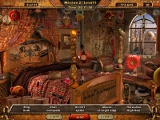
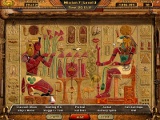
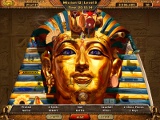
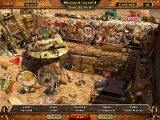

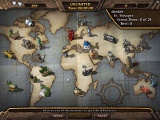
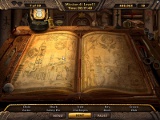
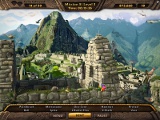
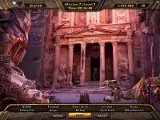
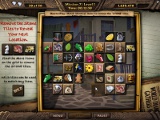
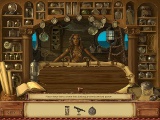
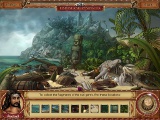
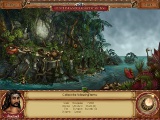
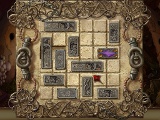
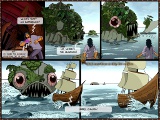
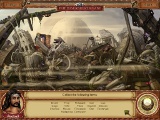
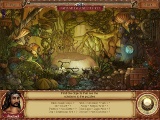
Magic Encyclopedia: First Story
Magic Encyclopedia: Illusions
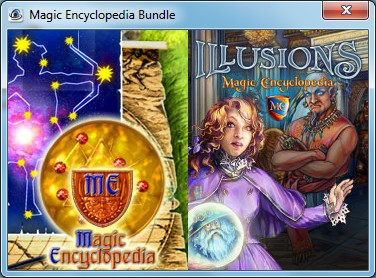
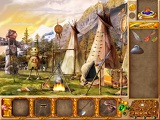
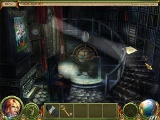
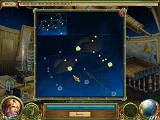
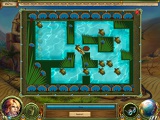
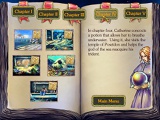
Samantha Swift and the Golden Touch
Midnight Mysteries: The Edgar Allan Poe Conspiracy
Luxor Adventures
